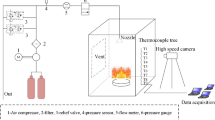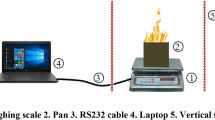Abstract
Due to the intense R&D activity in the field of water mist fire suppression during the past decade, the qualitative and quantitative understanding on the performance of water mist has increased significantly. This development has led to a point in which quantitative theoretical models describing large-scale water mist fire suppression systems begin to emerge. This paper describes the composition and validation of one such model, designed for total flooding water mist applications, especially against flammable liquid hazards in enclosures. The basic construction of the model is first described, followed by an example on the validation of the model using full-scale experimental data. The model is then used to investigate the limitations to the maximum possible mist concentration in the protected space. The potential of the model as an engineering tool is illustrated by making predictions on the scaling laws associated with water mist systems in the framework of IMO MSC/Circ.668/728 as the enclosure volumes and ventilation conditions are varied. The predictions are found to be in agreement with what is indicated by the recent US Coast Guard test series in very large machinery spaces.
Similar content being viewed by others
References
J.R. Mawhinney, and J.K. Richardson, “Status Report on Water Mist FireSuppression Systems-1996,” NISTIR 6030, National Institute of Standards and Technology, Gaithersburg, MD, 1997, pp.137–144.
Z. Liu, A.K. Kim, and J.S. Su,“Examination of the Extinguishment Performance of a Water Mist System Using Continuous and Cycling Discharges,” Fire Technology, vol.35, 1999, p. 336.
J.S. Pepi, “Advances in theTechnology of Intermediate Pressure Water Mist Systems for the Protection of Flammabel Liquid Hazards,” Proceedings of the Halon Options Technical Working Conference, Albuquerque, NM, 1998, p.417.
G. Back, B. Lattimer, C. Beyler, P. DiNenno, and R. Hansen, “Full-Scale Testing ofWater Mist Fire Suppression Systems for Small Machinery Spaces and Spaces with Combustible Boundaries-Volume 1,” USCG Report No CG-D–21–99, U.S. Coast Guard R&D Center, 1082 Shennecossett Road, Groton, CT, 1999.
G. Back, C. Beyler, P. DiNenno, and R. Hansen,“Water Mist Fire Protection for Very Large Machinery Spaces,” USCG Report No CG-D–15–00, U.S. Coast Guard R&D Center, 1082 Shennecossett Road, Groton, CT, 2000.
J. Mawhinney, “TheImportance of Fire Testing and the Design of Water Mist Fire Suppression Systems,” Fire Protection Engineering, Fall 1999, p.28.
C. Dubay, and J. Mawhinney, “Water Mist TechnologyEvolves” NFPA Journal, November/ December 1999, p.58.
G. Grant, J. Brenton, and D. Drysdale, “Fire Suppression by Water Sprays,” Progress in Energy and Combustion Science, vol.26, 2000, p.79.
L. Liu, and A.K. Kim, “Review of Water Mist Fire SuppressionSystems: Fundamental Studies,” Journal of Fire Protection Engineering, vol.10, 2000, pp.32–50.
R.W ighus, “Active Fire Protection-Extinguishment of Enclosed Gas Fires with WaterSprays,” SINTEF Report No.STF25 A91028, 1991.
G. Back, C.L. Beyler, P.J. DiNenno, R. Hansen, and R. Zalosh, “Full Scale Testing of Water Mist Fire Suppression Systems in Machinery Spaces,” USCG Report No CG-D–26–98, U.S. Coast Guard R&D Center, 1082 Shennecossett Road, Groton, CT, 1998.
G. Back, C. Beyler, and R. Hansen, “A Quasi Steady-state Model forPredicting Fire Suppression in Spaces Protected by Water Mist Systems,” Fire Safety Journal, vol.35, 2000, p.327.
J. Vaari, “Large-Scale fire extinguishing tests with water mists atVTT,” Proceedings of the 3rd Fire Suppression and Detection Research Application Symposium, Orlando, FL, 1999.
A.H. Lefebvre, Atomization and Sprays, Washington, DC: Hemisphere1989.
W.C. Hinds, Aerosol Technology: Properties, Behavior and Measurement of AirborneParticles, New York: Wiley, 1982.
D.B. Spalding, Fourth Symposium (International) onCombustion, Baltimore: The Williams & Wilkins Company, 1953, p.847.
A. Tewarson,The SFPE Handbook of Fire Protection, 2nd ed., P.J. DiNenno et al., Eds., Quincy, MA: NFPA, 1995, pp.3–53.
C.T. Ewing, J.T. Hughes, and H.W. Carhart, “TheExtinction of Hydrocarbon Flames based on the Heat-absorption Processes which Occur in them,” Fire and Materials, vol.8, 1984, p.148.
D.D. Drysdale, An Introduction to Fire Dynamics,2nd ed., Chichester: Wiley, 1999.
P. Andersson and G. Holmstedt, “Limitations ofWater Mist as a Total Flooding Agent,” Journal of Fire Protection Engineering, vol.9, 1999, p.31.
B.Z. Dlugogorski, R.K. Hichens, E.M. Kennedy, and J.W Bozzelli, “Water Vapour asan Inerting Agent,” Proceedings of the Halon Options Technical Working Conference, Albuquerque, NM (1997).
P.H. Thomas, Combustion Fundamentals of Fire, G. Cox, Ed.,London: Academic Press, 1995, pp.303–304.
MSC/Circ.668, ANNEX, APPENDIX BInterim test method for fire testing equivalent waterbased fire-extinguishing systems for machinery spaces of Category A, International Maritime Organization, London, 30 December 1994; MSC/Circ.728, ANNEX Amendments to the test method for equivalent water-based fire-extinguishing systems for machinery spaces of Category A contained in MSC/Circ.668, ANNEX, APPENDIX B, International Maritime Organization, London, 4 June 1996.
J. Vaari, “A Transient One-Zone Moder for Total FloodingWater Mist Fire Suppression in Ventilated Enclosures,” Fire Safety Journal, 2001, submitted.
Author information
Authors and Affiliations
Rights and permissions
About this article
Cite this article
Vaari, J. A Study of Total Flooding Water Mist Fire Suppression System Performance Using a Transient One-Zone Computer Model. Fire Technology 37, 327–342 (2001). https://doi.org/10.1023/A:1012772815499
Issue Date:
DOI: https://doi.org/10.1023/A:1012772815499




